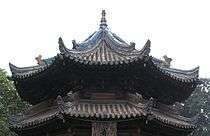Islam during the Song dynasty
The transition from the Tang to the Song dynasty (960–1279) in China did not greatly interrupt the trends of Muslims established during the Tang.
| Part of a series on Islam in China | ||||||
|---|---|---|---|---|---|---|
 | ||||||
|
||||||
|
| ||||||
Islam continues to increase its influence
Many Muslims began to go to China to trade during the Tang dynasty. During the Song dynasty, Muslims began to have a greater economic impact and influence on the country. During the Song dynasty (960–1279), Muslims in China dominated foreign trade and the import/export industry to the south and west.[1] Indeed, the office of Director General of Shipping for China's great seaport of Quanzhou was consistently held by a Muslim during this period.[2]
Meanwhile, Arabic storytellers were narrating fantastical stories of China, which were incorporated into the One Thousand and One Nights (Arabian Nights) as the "Tale of Qamar al-Zaman and Budur", "The Story of Prince Sayf al-Muluk", and "The Hunchback's Tale" story cycle.[3]
Migration of Muslims to China
In 1070, the Song emperor, Shen-tsung (Shenzong) invited 5,300 Arab men from Bukhara, to settle in China. The emperor used these men in his campaign against the Liao empire in the northeast. Later on these men were settled between the Sung capital of Kaifeng and Yenching (Yanjing, modern day Beijing).[4][5]The object was to create a buffer zone between the Chinese and the Liao. In 1080, 10,000 Arab men and women migrated to China on horseback and settled in all of the provinces of the north and north-east.[6]
The Arabs from Bukhara were under the leadership of Prince Amir Sayyid "So-fei-er" (his Chinese name is 索菲尔)[5]. The prince was later given an honorary title. He is reputed of being the "father" of the Muslim community in China. Prior to him Islam was named by the Tang and Song Chinese as Dashi fa ("law of the Arabs") (Tashi or Dashi is the Chinese rendering of Tazi—the name the Persian people used for the Arabs).[7] He renamed it to Huihui Jiao ("the Religion of the Huihui").[8]
Some Chinese officials from the Song dynasty era also married women from Dashi (Arabia).[9]
Notes
- BBC Religion and Ethics ISLAM Origins
- "ISLAM IN CHINA". Archived from the original on 2011-09-28. Retrieved 2007-04-15.
- Ulrich Marzolph, Richard van Leeuwen, Hassan Wassouf (2004). The Arabian Nights Encyclopedia. ABC-CLIO. pp. 521–2. ISBN 978-1-57607-204-2.
- Hagaras, Hamada (2017). "An Ancient Mosque in Ningbo-China, 'Historical and Architectural Study'". Journal of Islamic Architecture. 4 (3): 102–113. doi:10.18860/jia.v4i3.3851.
- Hagras, Hamada (2019). "Xi'an Daxuexi Alley Mosque: Historical and Architectural Study". Egyptian Journal of Archaeological and Restoration Studies "EJARS". 1: 97–113.
- Israeli (2002), pg. 283-4
- Israeli, Raphael (2002). Islam in China. United States of America: Lexington Books. ISBN 0-7391-0375-X.
- Israeli (2002), pg. 284
- Maria Jaschok, Jingjun Shui (2000). The history of women's mosques in Chinese Islam: a mosque of their own. Routledge. p. 74. ISBN 978-0-7007-1302-8. Retrieved 2010-06-29.